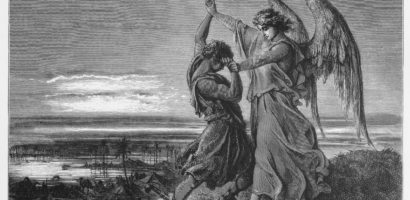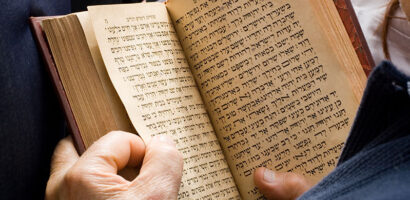THE HIDDEN MESSAGE
Finally we are entering the most interesting part of the story, the “action” of the story, which according to the text happens “a long time afterward”—a long time after the events we discussed in the previous part.
We read that a long time afterward”, “the daughter of Shua, Judah’s wife, died” – and when his period of mourning was over, “Judah went up to his sheepshearers at Timnah, he and his friend Hirah the Adullamite”. And here Tamar enters the picture again: we read that it was told Tamar, saying, “Look, your father-in-law is going up to Timnah to shear his sheep.” What did Tamar do upon hearing this news?
Let us remember that Tamar has been agunah for a long time already, for she was considered engaged to Shelah, and although “Shelah was grown, she was not given to him as a wife”. After the tragedy she had experienced (twice), it appeared that she would remain childless. However she decided that her father-in-law’s unfaithfulness would not stop her from having children and being a part of God’s family, so she pretended to be a prostitute in order to trap her father-in-law. She “took off her widow’s garments, covered herself with a veil and wrapped herself, and sat in an open place which was on the way to Timnah”
Most translations read that she sat in an open place. Sometimes, the name of the place where she was sitting is transliterated: “she sat down at the entrance to Enaim.” However, if we read the story of Judah and Tamar in Hebrew – we are struck by the name of the place: בְּפֶתַח עֵינַיִם BePetach Eyanim – literally: “in the opening of the eyes”. These words are incredibly meaningful and really designate what this story is all about—it’s about the “opening of the eyes”. At this point, Judah’s eyes are still closed, but they will not remain so. That’s why Tamar, God’s unexpected and unlikely tool, is sitting at this place – because God wants to open the eyes of Judah’s heart.
DISCERN, PLEASE
When Judah saw Tamar, he didn’t recognize her and took her for a prostitute. As payment for her service, he promised to send her a kid goat, which brings us back to the story of Joseph’s sale in the previous chapter. Do you remember that the brothers slaughtered a kid, dipped Joseph’s tunic in the blood, and then sent the tunic to their father? Moreover, when we see Jacob receiving this tunic, we can’t help but remember that the same set that Jacob was deceived with—special clothes and a slaughtered kid—was also used by Rebecca and Jacob to deceive Isaac! It seems that, beginning from Genesis 3, every time we have an animal and special garments, it serves as a cover-up for some serious sin or deceit. However, this story will end differently—it will be about the opening of the eyes. Therefore, Tamar asked for a pledge: “Will you give me a pledge till you send it?” She asked for his “signet and cord, and staff”, and surprisingly, he gave her these items.
We learn that through this trickery, Tamar becomes pregnant by Judah: “she conceived by him”. When, about three months later, Judah was told that “Tamar your daughter-in-law … is with child by harlotry,” Judah said, “Bring her out and let her be burned!” Tamar was still considered engaged to Shelah, and Judah, as head of the family, had judicial powers. His decision was both harsh and quick.
But then, something very significant happens. When Tamar brings out Judah’s personal items, she says: Discern, I pray thee – הַכֶּר־נָ֔א. In English, nothing strikes us as unusual in this sentence – however, in Hebrew one sees something that makes the connections between the two stories—the story of Joseph’s sale and the story of Judah and Tamar—absolutely evident. This expression, הַכֶּר־נָ֔א, discern, recognize, appears only twice in the entire Torah, and can you guess where it is first used? Right in the previous chapter, when the brothers bring Joseph’s coat to Jacob and say: discern please whether it be thy son’s coat: הַכֶּר־נָ֗א – discern, recognize, examine. Once again, in the entire Torah, this expression appears only in these two chapters: Genesis 37 and 38. In the first case, Judah was a deceiver, but now he is the one deceived. Judah’s deception revisits him in his very own words – and it is at this very moment, when Judah hears these words, that his heart is pierced by the recognition. Not only by the recognition of his own things, but much more deeply, by the recognition of his own guilt. Now his eyes are opened indeed, and he has a true change of heart. He confessed and repented.
JUDAH’S CONFESSION
We now come to the climax of this story – Judah’s confession: And Judah acknowledged them, and said, She hath been more righteous than I; because that I gave her not to Shelah my son.
We read a beautiful description of this transformation in Midrash: “Then Judah rose up and said: … I make it known that with what measure a man metes it shall measured unto him, be it for good or for evil, but happy the man that acknowledgeth his sins. Because I took the coat of Joseph, and colored it with the blood of a kid, and then laid it at the feet of my father, saying: Know now whether it be thy son’s coat or not, therefore must I now confess, before the court, unto whom belongeth this signet, this mantle, and this staff.”
Of course Midrash just fills in the gaps that Scripture leaves out. Yet, there is a point not to be missed: Judah is the very first Biblical figure who is ready to acknowledge his sin. Instead of saying: ‘she is the one to blame’, like Adam, Judah says: ‘I am the one to blame.’ She has been more righteous than I. Judah is the first person in the book of Genesis – and therefore the entire Bible – to confess his sin, take responsibility for it, and change his behavior: he repents. Moreover, he doesn’t do it under external pressure: her social status was incomparable lower than his—a woman, a widow, and probably Canaanite. If his word was against her word, nobody would believe her. But God wanted to open the eyes of his heart, and therefore we witness his profound inner transformation. Scripture makes sure we know that the Judah who later comes to Egypt and talks to Joseph, is not the same Judah we saw in chapter 37: this Judah has gone through a deep transformation—he has a different heart.
Next time, in our final post on Judah, we will see how this transformation would affect the whole Joseph story – and the whole story of Israel as well.
If the articles on this blog whet your appetite for discovering the hidden treasures of the Hebrew Bible, I would be happy to provide more information (and also a teacher’s discount) regarding our amazing courses.









That was so amazing! Thank you!
This story inserted as it is in the Joseph narrative has always been jarring to me, and while I was able to understand about half of it, the Biblical Hebrew you have pointed out to us here Julia, reveals so much more – so beautifully. It’s amazing that our God can use even our shortcomings and sins to open the eyes of our hearts.
Wow! All these years I have known these two stories as if they were independent of each other and never putting the Judah as the same Judah… how silly of me! What a great article this is to “open MY eyes” as well! Thank you so much Julia! Blessings in abundance with wisdom, I pray for you!
Thanks Julia! Great teaching! I think this story is second only to the binding of Isaac.
What about Eve being the first sinner who repents? I agree Judah repented, but I also think Eve did also. Do you think she did not?
As always, a very exciting stuff. I’m blessed.
Thanks Prof. Blum
Shalom
I’ve always found the story of Tamar to be a fascinating one, especially as her son Perez is named as an ancestor of Yeshua. Mind-boggling!
Julia,
A beautiful exposition of a rather difficult and disconcerting passage.
As you have rightly pointed out: from Breshit 3:5 we see that sin brings about an opening of the eyes to discern between good and evil. The same process repeats itself time and time again as we follow the scripture narrative.
This time, however, Judah repented of his sin and this led, in the fullness of time, to his tribe bringing forth the Messiah.
I love j. Blum, she helped me better understand the Bible.. More power!!!!
Just finished reading Biblical Portraits: Judah (3). That was wonderful! Want to read the next Portrait of Judah. Is it posted yet? Thanks for all those amazing insights into Judah’s character! Kim